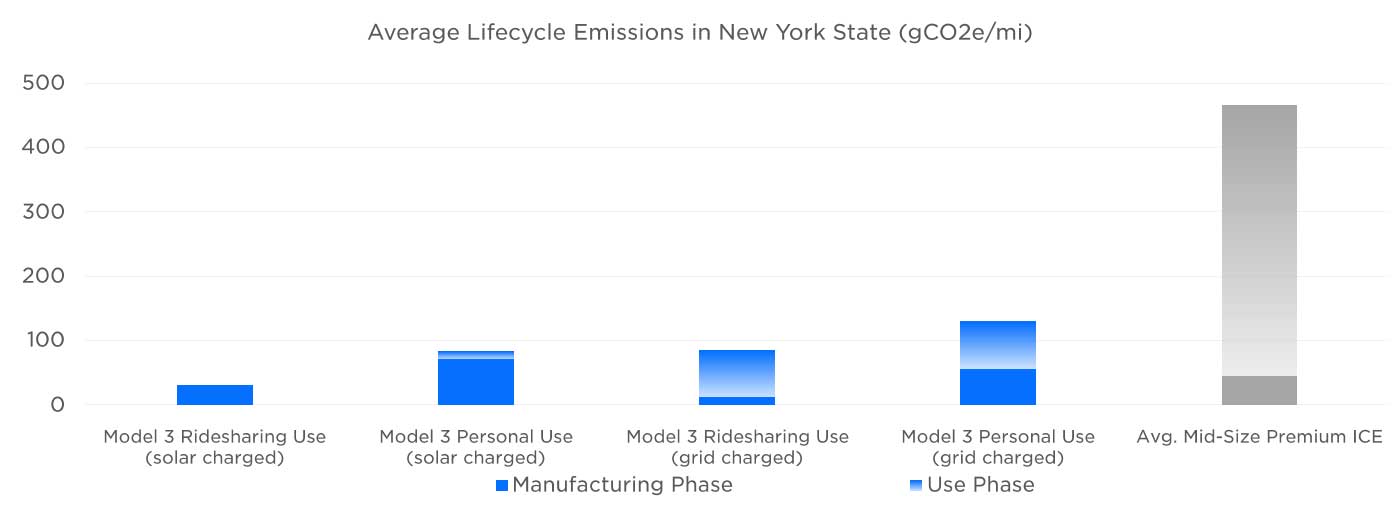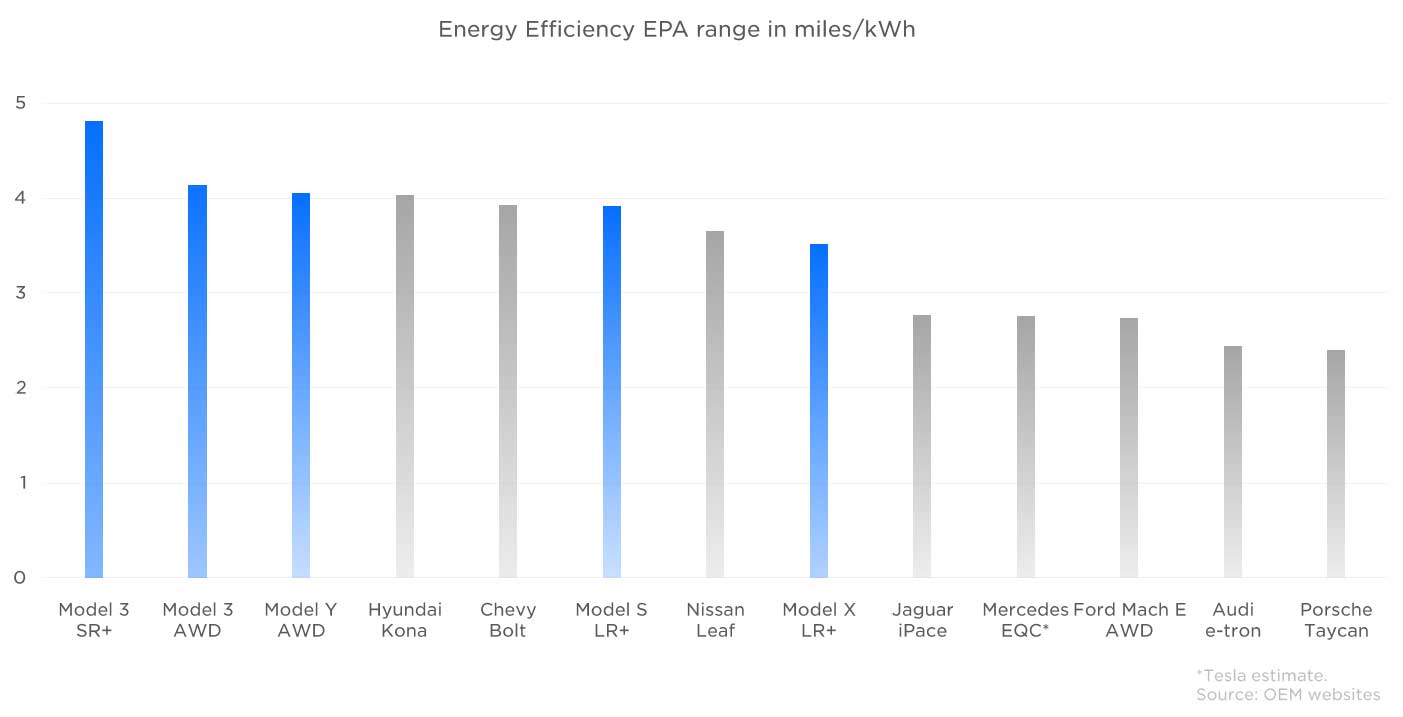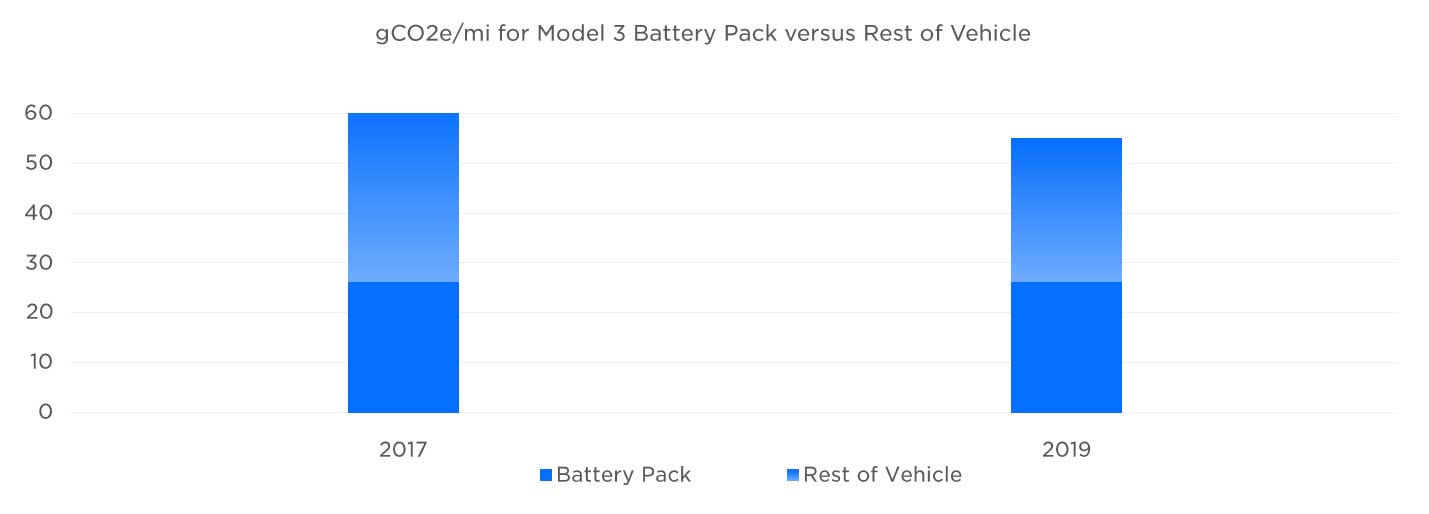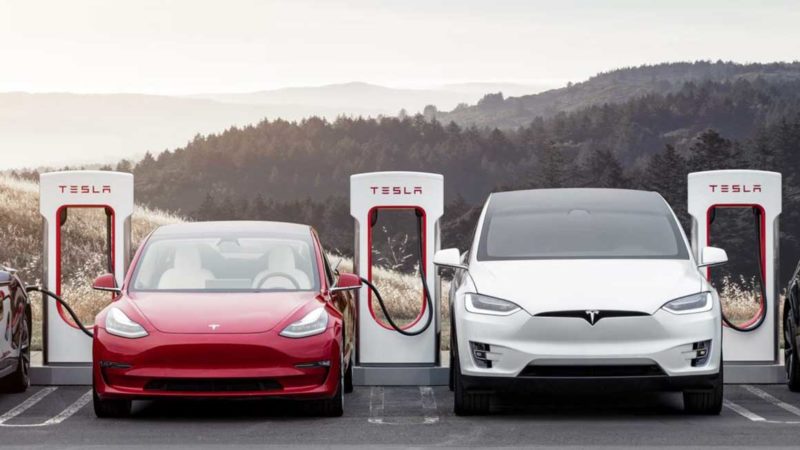The Tesla Model 3 electric car has half the impact of rival petrol and diesel vehicles in terms of carbon emissions over its entire lifecycle, and could achieve a fraction of the impact of a privately owned car when used as part of an autonomous “robo-taxi” fleet, says Tesla.
It is often falsely claimed that electric vehicles are worse for the environment because of emissions associated with the manufacture of batteries, or due to charging from coal-fired grids. The widely debunked Michael Moore documentary “Planet of the Humans” repeated those myths.
Tesla, in its 2019 impact report released this week, shows that its EVs produce far less carbon than internal combustion engine (ICE) vehicles, even when including emissions from manufacture and charging from fossil fuels.
The report, which compares energy consumption data from 4 billion miles (6.4 billion kilometres) driven by Tesla vehicles against real world consumption data from consumer advocacy site Consumer Reports, shows that not only are Tesla vehicles becoming more efficient over time, they will continue to do so.
It is Tesla’s plan for a “robotaxi” fleet which promises the most savings in terms of lifecycle emissions, revealing a key reasoning behind the EV and battery maker’s dual strategy to address both transport and energy generation and storage.
Using a “million-mile battery”, such as that expected to be revealed at Tesla’s upcoming battery day and which its Chinese battery partner CATL says it is now ready to make, Tesla would be able to dramatically reduce the carbon emissions per kilometre driven by its vehicles.
According to Tesla’s calculations, robotaxis provide the lowest emissions per mile, with zero use phase emissions assuming they are “used for ride-sharing over one million miles using cell chemistry from our energy products and it were only charged using a solar system and energy storage”.
“Such an effort dramatically reduces the lifetime carbon footprint of an EV, even when accounting for the carbon footprint of both the solar panel/Solar roof and Powerwall manufacturing,” the company states.
Unlike ICE vehicles which become less efficient over time unless subjected to a rigorous maintenance schedule, electric vehicles become more efficient as electricity grids transition to cleaner energy sources, the report says.
It’s hard to predict exactly how quickly grids will transition though, and for this reason Tesla assumes no reduction in grid emissions in its report.
Regardless, the difference in current lifecycle emissions between the Model 3 and an average mid-sized premium ICE vehicle is huge.
Assuming the vehicle is driven 12,000 miles (19,312km) annually over a period of 17 years, Consumer Reports data shows that the average miles per gallon (MPG) for the ICE vehicle is 23.6 MPG (9.97 litres/100km).
In comparison, the Model 3 averages the equivalent of 55 MPG (4.28 litres/100km) when powered off a fossil fuel-reliant grid such as Michigan, where 64% of energy comes coal and gas.
(It is not entirely clear why Tesla has calculated smaller emissions for ride-sharing powered by the grid, as we assume this is a flat emissions calculation divided by the distance a vehicle is expected to drive.)

In greener states such as New York, Tesla notes the impact is even more marked.
“To put this in perspective, average GHG emissions from charging one New York-based Tesla vehicle equates to the emissions from an ICE vehicle with a fuel economy of 144 MPG (no such vehicle is on the market),” the report reads. In metric terms, this equates to just 1.63 litres per 100km driven.
Add in charging directly from solar panels or energy stored in batteries via solar, and the results are even better – in the case of personal use, which assumes 18% of charging is done using public fast-charging networks, the use phase emissions (as opposed to emissions generated during the manufacture of the vehicle) approach zero.

In addition to reduced emissions due to the transition of grids to renewable sources, Tesla says that improvements in powertrain efficiency place the Model 3 Standard Range Plus (SR+) as the most efficient electric vehicle on the market.
Tesla says the Model 3 SR+ achieves 4.8 miles/kWh (7.7km/kWh) according to the US-based EPA fuel economy ratings, and the Model Y achieves 4.1 miles/kWh making it the most efficient electric SUV on the market.
The efficiency of its competitors also reveals an interesting trend, which is that premium models tend to be less energy efficient than their more affordable stablemates.

Further efficiencies are being worked towards at its factories. While its Operations Energy Efficiency Program (OEEP) has seen manufacturing phase emissions for its Tesla Model 3, for example, reduce from about 35gCO2e/mile to around 30gCO2e/mile, it also notes that its goal to sources parts locally at its Shanghai factory will also reduce shipping-related emissions.


Bridie Schmidt is associate editor for The Driven, sister site of Renew Economy. She has been writing about electric vehicles since 2018, and has a keen interest in the role that zero-emissions transport has to play in sustainability. She has participated in podcasts such as Download This Show with Marc Fennell and Shirtloads of Science with Karl Kruszelnicki and is co-organiser of the Northern Rivers Electric Vehicle Forum. Bridie also owns a Tesla Model Y and has it available for hire on evee.com.au.

